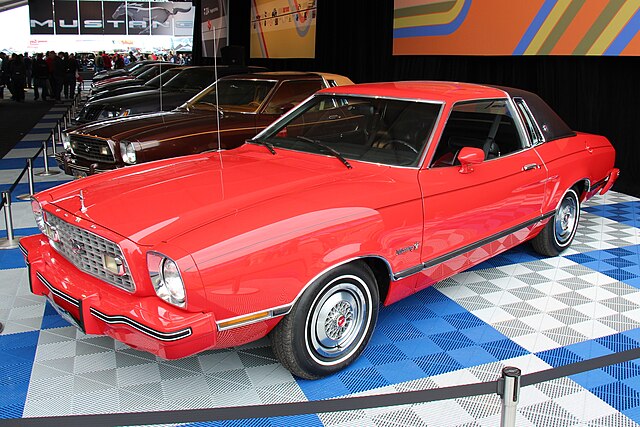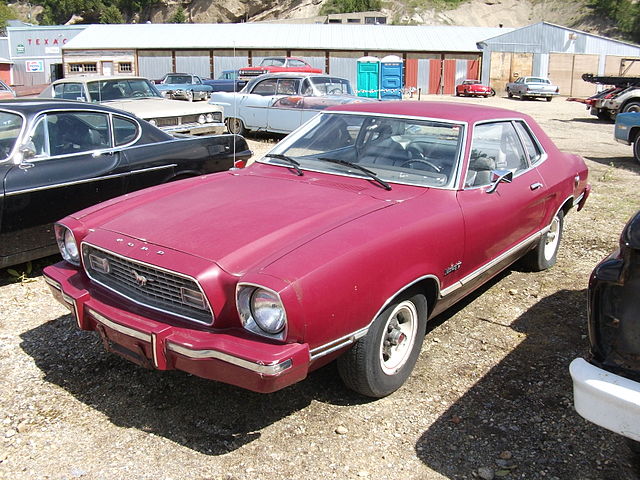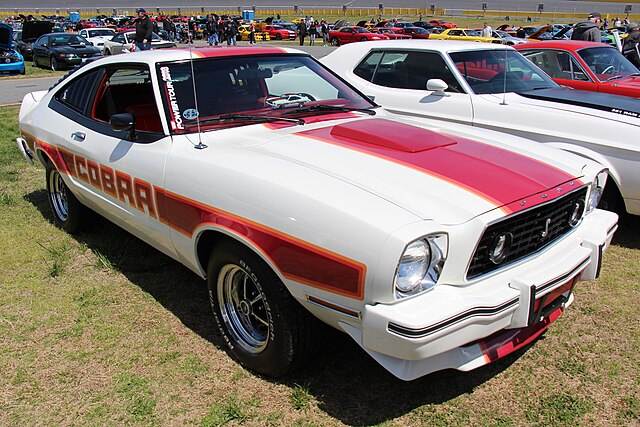
The Ford Mustang II, the second generation of one of America’s most iconic sports cars, marked a significant shift in design and engineering philosophy from its predecessor. Introduced in 1973 and produced until 1978, this model was developed in response to the changing demands of the market, influenced heavily by the oil crisis of 1973 and a growing consumer interest in smaller, more fuel-efficient vehicles.
The Mustang II was smaller than the first generation, yet it retained the Mustang’s essence through its stylish design and adaptable performance options.
Design and Development

The design of the Ford Mustang II was a radical departure from the large, powerful pony cars of the 1960s. Under the leadership of Lee Iacocca, Ford aimed to return to the Mustang’s original concept as a compact, stylish, and affordable car.
The new design was based on the subcompact Ford Pinto platform, which allowed for reduced production costs and better fuel efficiency—a crucial selling point during the oil crisis era.
The Mustang II’s styling incorporated a mix of European design influences with traditional Mustang styling cues. This generation featured a variety of body styles, including a two-door coupe and a three-door hatchback.
The reintroduction of the hatchback was aimed at providing practicality along with sporty aesthetics. Despite its smaller size, the design included luxury elements like plush interiors and extensive trim options, positioning it as a more upscale vehicle than its predecessor.
Ford’s engineering efforts were focused on making the Mustang II suitable for its time. It offered a range of powertrains from a modest 2.3-liter four-cylinder engine to a 2.8-liter V6, and later, a 302 cu in (5.0 L) V8, reintroducing performance options that appealed to traditional Mustang enthusiasts.
The car’s construction featured improved safety measures, a response to increasing safety regulations, which included a heavier chassis and standard features such as front disc brakes.
Model Variants and Special Editions

Throughout its production run, the Mustang II offered several model variants that catered to different tastes and performance needs. The base model was economically priced and aimed at buyers seeking an attractive yet affordable car. The Ghia model, named after the famed Italian design house, offered a more luxurious approach with better-appointed interiors and additional comfort features.
The sporty Mach 1 variant catered to those who missed the performance edge of earlier Mustangs. Equipped with a V6 or an optional V8 engine, the Mach 1 featured a sports suspension, racing stripes, and a performance-tuned exhaust system. Additionally, Ford introduced the Cobra II in 1976, which offered cosmetic upgrades such as a front air dam, a rear spoiler, and distinctive Cobra badging, although it didn’t significantly enhance performance until later models.
Special editions such as the “King Cobra,” available in 1978, were attempts to rekindle the high-performance image of the Mustang. It featured a V8 engine, a distinctive front spoiler, and a graphics package that included a cobra snake decal on the hood—elements designed to mimic the muscle cars of the past in a period dominated by emissions controls and fuel economy concerns.
Reception and Legacy

The initial reception of the Mustang II was largely positive, with the model winning the Motor Trend Car of the Year award in 1974. This recognition was attributed to Ford’s ability to adapt the Mustang to a changing automotive landscape, presenting a vehicle that met contemporary needs for fuel efficiency and environmental consideration without entirely sacrificing the Mustang’s sporty image.
Despite its success in the 1970s, the Mustang II has faced criticism in later years, often viewed as a low point in the Mustang lineage due to its performance limitations and departure from the original muscle car ethos.
However, it played a crucial role in keeping the Mustang line viable during a difficult period in the automotive industry, bridging the gap between the first generation’s muscle car roots and the later models’ return to performance.
Conclusion: The Mustang II’s Place in Automotive History
The Ford Mustang II remains a polarizing figure in automotive history. While not the most powerful or beloved in the Mustang series, its significance lies in its role in adapting an iconic brand to meet the challenges of its time. It exemplifies a transitional period in American automotive design, where the necessity of innovation was driven by external economic pressures and changing consumer preferences.
The Mustang II’s legacy is a testament to Ford’s ability to evolve and sustain its marquee models through varying eras of car manufacturing and market demands.
